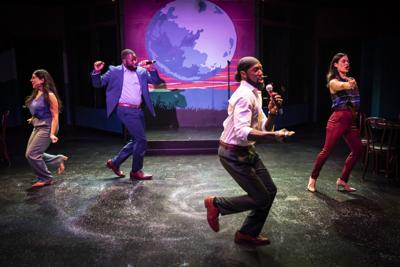“Songs for a New World” put Jason Robert Brown on the map when it premiered at New York's WPA Theatre in 1995, and though it has been eclipsed by the composer-lyricist's “The Last Five Years,” “Parade” and other musicals, the revue holds up surprisingly well after more than a quarter of a century.
The themes of change and uncertainty, heralded in the opening number, suit our current situation especially well, and the struggle between hope and despair would resonate anytime. Sure, some of the songs are dated or marred by notions that are no longer acceptable, and a couple too many are soaring anthems, but they're balanced by forays that are funny, even if they're out of place, and love songs that tend to be bittersweet rather than sappy.
Theo Ubique Cabaret Theatre's lively production, directed by Fred Anzevino and choreographed by assistant director Jamal Howard, features four immensely talented performers: Nora Navarro, Emily Goldberg, Eustace J. Williams and Matthew Hunter. Each has chances to shine in solos, duets and company pieces.
The opening sequence starts with Navarro joyously belting out “The New World,” a celebration of a new day in a bright new land. But in the second half, “On the Deck of a Spanish Sailing Ship, 1492,” Williams reveals the dark side, a portrait of hungry, desperate men that can't help but conjure up the slave trade. While many of the love songs fall to Navarro, often partnered with Hunter, Williams cannily executes the complicated “Steam Train,” “King of the World” and “Flying Home,” drawing on his enormous range, including a beautiful falsetto.
Goldberg gets the bulk of the comic songs, among them “Just One Step,” about an unhappy woman contemplating suicide, which she plays for laughs, and the even broader “Surabaya-Santa,” Mrs, Claus's increasingly distraught rant about “Nick” and his antics. She also delivers “Stars and the Moon,” a piquant-poignant look at love, longing and materialism that boils down to a warning to be careful what you wish for, and that has become a staple of cabarets.
Anzevino's staging takes advantage of every part of Theo Ubique's intimate space, so sometimes the performers are just a foot or two away from you, and often they look you right in the eyes. Howard's choreography isn't flashy, but it keeps the energy flowing, though occasionally a bit too busily.
Production designer James Kolditz's set is simple but functional. The centerpiece, on the back wall, is a painting of a globe that resembles the earth except that it has no recognizable masses of land or water, making it, in essence, a new world.
Behind that wall is musical director Jeremy Ramey, who also is the conductor and keyboardist of the “orchestra,” which consists of him and percussionist Dr. Lior Shragg. They produce an amazing amount of sound — and also cause the show's main problem.
Ramey and the cast can't see each other or interact, and the evening would be much better musically if they could. As it is now, they often are in competition with each other, so the music threatens to drown out the singers or they become so loud that the amplification distorts their voices to the extent that the lyrics are indecipherable.
This issue seems relatively easy to resolve, particularly now that Theo Ubique has a bigger theater than its old postage-stamp space in Rogers Park. Let's hope it will be before the next production, because otherwise, “Songs for a New World” is quite enjoyable.



(0) comments
Welcome to the discussion.
Log In
Keep it Clean. Please avoid obscene, vulgar, lewd, racist or sexually-oriented language.
PLEASE TURN OFF YOUR CAPS LOCK.
Don't Threaten. Threats of harming another person will not be tolerated.
Be Truthful. Don't knowingly lie about anyone or anything.
Be Nice. No racism, sexism or any sort of -ism that is degrading to another person.
Be Proactive. Use the 'Report' link on each comment to let us know of abusive posts.
Share with Us. We'd love to hear eyewitness accounts, the history behind an article.